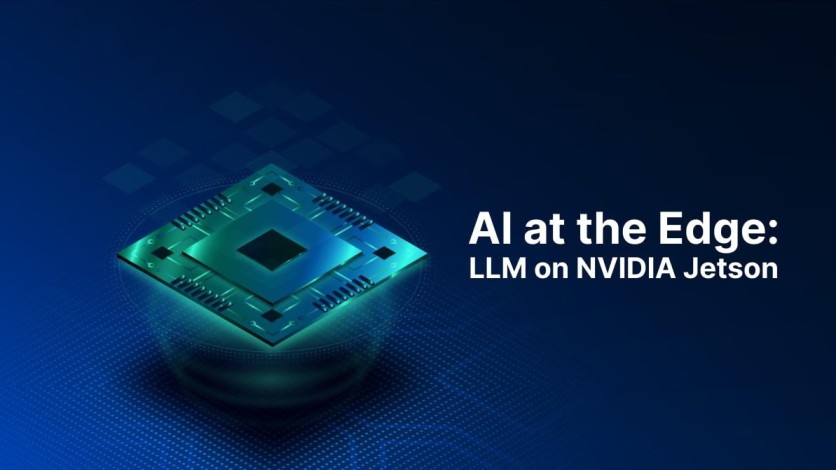
Demand for AI solutions is rising—and with it, the need for edge AI is growing as well, emerging as a key focus in applied machine learning. The launch of LLM on NVIDIA Jetson has become a true breakthrough in this area. The process reduces cloud dependency, lowers latency, and accelerates decision-making directly at the source of data generation.
Davyd Maiboroda, an AI solutions architect, software engineer, and researcher with over 15 years of experience, has worked extensively on creating pipelines that enable the use of advanced AI models in resource-constrained environments. In this article, he shares his experience with edge deployments to create more autonomous AI systems.
Designing an LLM Pipeline for Jetson
Davyd Maiboroda recalls the workflow of the LLM pipeline for NVIDIA Jetson, which consisted of several stages. Drawing on his previous experience working on real-time machine vision and behavioral classification pipelines, Maiboroda approached the task as both a researcher and an engineer.
First, he preprocessed the data and structured it to ensure low latency. Davyd Maiboroda then concentrated on adapting LLM to the Jetson GPU architecture. TensorRT acceleration and large model optimization were required to shorten inference time without appreciably lowering accuracy. He also used the DeepStream SDK to integrate real-time data streams so that LLM could continuously process text and respond quickly to practical apps such as voice assistants or smart cameras.
The next stage involved combining preprocessing, GPU-level optimization, and data streaming. Ultimately, Maiboroda confirmed that even devices with limited resources can support complex language models.
Overcoming Hardware Limitations
Limited memory, processing power, and possible inference latency are some of the difficulties associated with running LLM on small hardware. However, there is always a curious mind looking for a solution when issues arise. Maiboroda used his own optimization technique as a result. First, the engineer reduced the model size by removing unnecessary parameters and restructuring its layers. This allowed Davyd to reduce large models to formats that could be hosted on Jetson.
Next came the quantization process. Maiboroda converted parameters from 32-bit floating-point numbers to lower-precision formats, such as INT8. This reduced memory consumption and inference time while maintaining accuracy within acceptable limits.
Another key optimization method was the use of compression and weight distribution algorithms to reduce redundancy within models. Maiboroda combined this with TensorRT optimization, resulting in models that ran efficiently on the Jetson architecture, especially given the continuous data flow. As a result of his work LLM pipelines on Jetson, Maiboroda discovered that striking a balance between efficiency and accuracy is a constant challenge. He used the same lessons he learned in the LLM backend deployment: benchmarking, iterative testing, and fine-tuning until the models were robust and responsive.
According to Maiboroda, the complexity of deploying to edge devices forces engineers to develop more thoughtful solutions. "It's not about squeezing a huge model into a small space," he explains, "but about reshaping the space and the model so they work together seamlessly." This has become his philosophy.
Real-World Application of AI
Deploying LLMs on NVIDIA Jetson has gone beyond the experimental stage and enabled the creation of real-world applications across various industries. Davyd Maiboroda recalled several similar use cases.
Maiboroda helped create conversational AI on Jetson hardware for booking and customer interaction. This solution featured reduced response times and full user control over data processing. As Davyd notes, combining speech-to-text functionality with optimized LLMs allowed the AI to instantly respond to natural language commands, bypassing the cloud.
Intelligent cameras and computer vision systems are two more significant use cases on Jetson. Maiboroda modified Jetson devices to run lightweight models for continuous video analysis, drawing on his experience creating pipelines for user behavior classification. These systems are useful for retail analytics, security applications, and industrial monitoring because they can identify actions, spot irregularities, and send out alerts instantly.
Autonomous systems in robotics can process data, interpret instructions, and make context-sensitive decisions thanks to Jetson-based models. Because of his background in advanced AI and unmanned robotics, Maiboroda thinks that natural language processing and built-in decision-making skills can be combined to make robots that are easy for people to understand.
All these cases exemplify how flexible and scalable edge deployments can be. The ability to run optimized AI locally enables the creation of AI systems that are faster, safer, and better suited to real-world requirements.
The Future of LLMs at the Edge
Reflecting on his experience, Davyd Maiboroda sees the future of edge AI in making LLM smaller and more adaptive. He points out that the next wave of AI systems will combine natural interaction, autonomous decision-making, and real-time responsiveness—all running directly on compact, energy-efficient devices such as NVIDIA Jetson.
This shift could expand access to AI technologies. What was previously available only in data centers and labs can now appear on everyday devices. Furthermore, new business models based on local intelligence will be more easily implemented in robotics, retail, and industrial monitoring. Such devices include smart cameras and autonomous service robots.
According to Maiboroda, the development of LLMs is a significant step toward a time when AI will be effortlessly incorporated into the tools, systems, and devices that people already use on a daily basis.

-
 C114 Communication Network
C114 Communication Network -
 Communication Home
Communication Home


